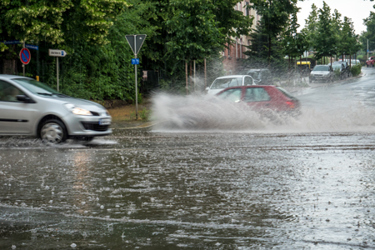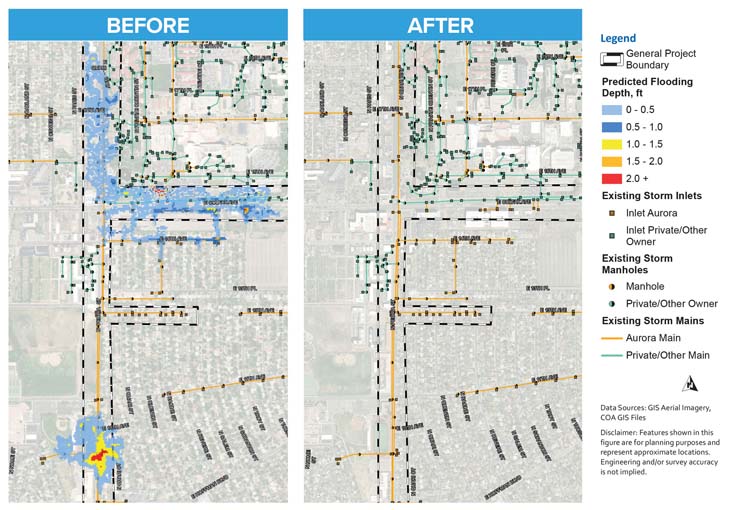Reducing Flood Risk In A Highly Urbanized Area
By Caroline Burger, Jim Kriss, and Swirvine Nyirenda

How the city of Aurora, CO, via the Fitzsimmons-Peoria Stormwater Outfall Project, modernized outdated infrastructure in response to current needs and future threats.
Most urban areas in the U.S. were built before stormwater managers truly understood the impact of converting pervious areas into impervious areas or just how much the population would grow — both in number and geographic area. As a result, a significant portion of stormwater infrastructure, particularly in the older portions of our cities and towns, are well undersized for the intended levels of service.
Reducing Flooding Risk In An Older Portion Of The City Of Aurora
A highly congested and rapidly developing area of the city was subject to chronic flooding due to undersized stormwater infrastructure constructed in the 1970s. As a result, the city prioritized the implementation of the Fitzsimmons-Peoria Stormwater Outfall Project to comply with current stormwater standards. The project was a large-scale effort that replaced approximately 15,000 feet of aging 24- to 96-inch storm drain pipes through a highly urbanized area undergoing rapid redevelopment. The improvements will provide improved flood protection for approximately 230 residences and 40 businesses.
To meet these goals, Carollo Engineers assisted the city with engaging a construction manager at risk (CMAR) contractor, BT Construction. The final design efforts were completed as a collaborative team consisting of the city, the CMAR contractor, and Carollo. Together, the team evaluated alternatives to mitigate these constraints throughout the project while minimizing public disruption and project cost.
Sewer Modeling And Enhanced Construction Techniques
Computer Modeling Efforts
Carollo conducted a complex computer modeling effort using InfoWorks ICM in both 1-dimensional (1-D) and 2-D components. These models were constructed to confirm that the new stormwater pipeline and connections were sized to adequately convey predicted stormwater flows, reducing the risk of flooding. The 1-D components evaluated underground infrastructure; the 2-D components evaluated how much stormwater would remain on the ground surface.
Pipeline Design and Construction
Pipeline routing was established to protect existing utilities and infrastructure while minimizing disruptions to traffic. Pipeline alignments were selected with consideration of construction sequencing, required traffic control devices and diversions, cost, and construction duration. The project also required numerous large manholes and junction structures. These structures were designed as a combination of both cast-in-place and pre-cast structures, with a preference for pre-cast to minimize construction duration where feasible.
Most of the pipeline was constructed using open-trench construction with passive shoring (trench boxes) and some limited active shoring (slide rail with minimal dewatering needed using sump pumps). Four major arterials required large diameter trenchless crossings. The variability of ground conditions required a combination of open-face tunnel boring machine (TBM) for two of the tunnels and closed-face microtunnel boring machine (MTBM) for the other two crossings. The city, CMAR contractor, and Carollo evaluated each construction technique and approach with consideration of cost, feasibility, safety, and minimizing public impact.
Successful Project Outcome And Delivery
The new storm drain system has the capacity to collect and convey a larger flow rate to the discharge at Sand Creek. Carollo performed Hydrologic Engineering Center’s River Analysis System (HECRAS) modeling of Sand Creek utilizing the existing published Federal Emergency Management Agency (FEMA) Flood Insurance Rate Map (FIRM) maps and base flood elevations with new flow rate inputs for the project basin. While the discharge flow rate increased significantly, the discharge time was well ahead of the peak attenuation of base flood elevations at our discharge location. Therefore, we were able to prove a no-rise condition and avoided the need to submit a Letter of Map Revision (LOMR).
Notable Project Design Elements
- Minimizing construction impact. Measures were taken to minimize disruptions to the community, as portions of the existing infrastructure flow through highly developed areas.
- Trenchless crossings of major roadways. These were needed to minimize traffic disruptions. Variability in ground conditions required different trenchless technologies to ensure successful installations.
- Discharges not affecting the regulated Sand Creek floodplain. Our team proved that the increased flows would result in a no-rise condition of the floodplain to avoid a LOMR.
About The Authors
 Caroline Burger, PE, is Chief Technologist, Stormwater at Carollo and has 22 years of experience working with public and private clients. Her expertise includes urban hydrologic, hydraulic- and nonpoint-source pollution modeling and design, stormwater utility development, and program management. She has developed numerous municipal stormwater management plans for municipalities across the country. Caroline is a previous engineering division employee for the city of Madison, WI, where she led the city’s Watershed Study Program. Caroline is also a partner in PV & Associates and helps to develop the urban water quality model WinSLAMM.
Caroline Burger, PE, is Chief Technologist, Stormwater at Carollo and has 22 years of experience working with public and private clients. Her expertise includes urban hydrologic, hydraulic- and nonpoint-source pollution modeling and design, stormwater utility development, and program management. She has developed numerous municipal stormwater management plans for municipalities across the country. Caroline is a previous engineering division employee for the city of Madison, WI, where she led the city’s Watershed Study Program. Caroline is also a partner in PV & Associates and helps to develop the urban water quality model WinSLAMM.
 Jim Kriss, PE, is Principal Infrastructure Engineer at Carollo and was the project manager for the Fitzsimmons-Peoria Stormwater Outfall. He has 32 years of design and construction experience, incorporating both traditional and alternative project delivery methods. His expertise includes mechanical pumping and piping systems, pipelines, sanitary and storm sewer pipelines, sanitary force mains, hydraulic design and modeling.
Jim Kriss, PE, is Principal Infrastructure Engineer at Carollo and was the project manager for the Fitzsimmons-Peoria Stormwater Outfall. He has 32 years of design and construction experience, incorporating both traditional and alternative project delivery methods. His expertise includes mechanical pumping and piping systems, pipelines, sanitary and storm sewer pipelines, sanitary force mains, hydraulic design and modeling.
 Swirvine Nyirenda, PE, CFM, is project delivery services manager in the planning and engineering division of Aurora Water, whose project delivery services team executes a capital improvement program of approximately $150 million per year. He has a master’s degree in environmental engineering from Tulane University.
Swirvine Nyirenda, PE, CFM, is project delivery services manager in the planning and engineering division of Aurora Water, whose project delivery services team executes a capital improvement program of approximately $150 million per year. He has a master’s degree in environmental engineering from Tulane University.
